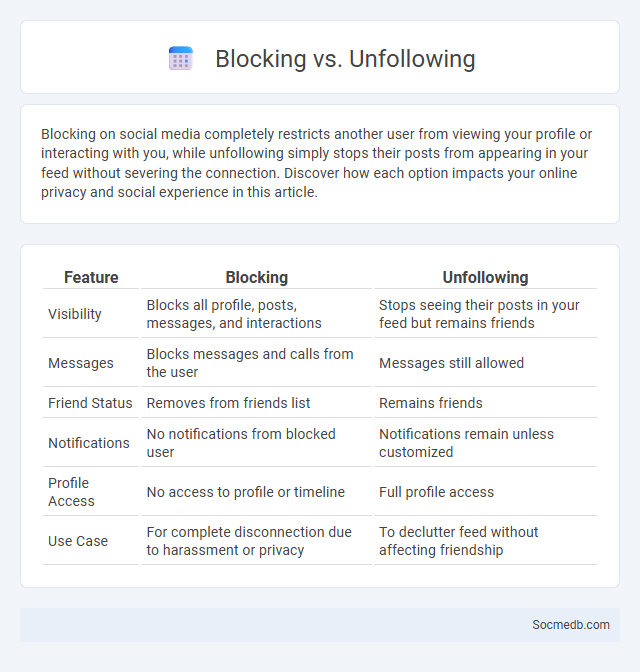
Photo illustration: Blocking vs Unfollowing
Blocking on social media completely restricts another user from viewing your profile or interacting with you, while unfollowing simply stops their posts from appearing in your feed without severing the connection. Discover how each option impacts your online privacy and social experience in this article.
Table of Comparison
| Feature | Blocking | Unfollowing |
|---|---|---|
| Visibility | Blocks all profile, posts, messages, and interactions | Stops seeing their posts in your feed but remains friends |
| Messages | Blocks messages and calls from the user | Messages still allowed |
| Friend Status | Removes from friends list | Remains friends |
| Notifications | No notifications from blocked user | Notifications remain unless customized |
| Profile Access | No access to profile or timeline | Full profile access |
| Use Case | For complete disconnection due to harassment or privacy | To declutter feed without affecting friendship |
Understanding Online Boundaries: Blocking, Unfollowing, and Privacy
Understanding online boundaries is essential for maintaining digital well-being and controlling social media interactions through blocking, unfollowing, and privacy settings. Blocking prevents unwanted contact by restricting specific users from viewing profiles or messaging, while unfollowing removes content from the feed without notifying the other party. Adjusting privacy settings allows users to control who can see posts, personal information, and activity, ensuring a safer and more personalized online experience.
What Does Blocking Mean on Social Media?
Blocking on social media means restricting another user from viewing your profile, sending messages, or interacting with your posts, creating a barrier that protects your online space. Your blocked user will no longer see your content or be able to search for your account, effectively cutting off digital communication. This feature empowers you to control your online experience, ensuring safety and privacy from unwanted interactions.
The Effects of Unfollowing: Subtle Disengagement
Unfollowing on social media often signals subtle disengagement, reducing content visibility and weakening perceived social connections. This behavior can lead to decreased interaction rates and a gradual erosion of online social capital. Understanding the psychological impact of unfollowing helps explain shifting dynamics in digital relationships and content consumption patterns.
Privacy Settings: Guarding Your Digital Space
Privacy settings on social media platforms empower you to control who can view your personal information, posts, and interactions, ensuring your digital space remains secure. Regularly updating and customizing these settings helps prevent unauthorized access, data breaches, and digital stalking. Mastering privacy controls safeguards your online identity and fosters a safer social media experience.
Key Differences: Blocking vs. Unfollowing vs. Privacy Controls
Blocking on social media completely restricts another user from viewing your profile, messaging you, or interacting in any way, providing the highest level of personal control and security. Unfollowing stops your feed from displaying that user's content without notifying them, maintaining a passive disconnection while preserving mutual visibility. Privacy controls allow users to selectively limit who can see posts, comment, or share personal information, enabling customizable boundaries without severing connections.
Social Consequences: How Connections Are Impacted
Social media reshapes your social connections by enabling instant communication but can also lead to superficial relationships and decreased face-to-face interactions. The constant exposure to curated content influences self-esteem and social comparison, affecting emotional well-being. Overreliance on digital platforms may weaken deep, meaningful connections, impacting overall social dynamics and personal relationships.
When to Use Block, Unfollow, or Adjust Privacy Settings
Blocking on social media is ideal when you need to prevent harassment or completely restrict access to your profile, ensuring your safety and peace of mind. Unfollowing is a subtle way to declutter your feed without alerting others, useful for reducing exposure to unwanted content while maintaining connections. Adjusting privacy settings gives you control over who sees your posts and personal information, empowering you to tailor your online presence to fit Your comfort and security preferences.
Platform-Specific Features: Facebook, Instagram, and More
Facebook offers robust community-building tools such as Groups and Events, facilitating direct interaction and engagement among users. Instagram emphasizes visual storytelling through features like Stories, Reels, and Shopping, which cater to brands and influencers aiming for immersive audience experiences. LinkedIn targets professional networking with specialized functionalities like endorsements, job postings, and in-depth profile customization, optimizing career development and business opportunities.
Pros and Cons of Each Action for Online Wellbeing
Engaging with social media can enhance online wellbeing by fostering community support, providing access to valuable information, and encouraging self-expression, which boosts mental health and social connectivity. However, excessive use may lead to reduced face-to-face interactions, increased exposure to cyberbullying, and heightened anxiety due to social comparison and information overload. Balancing screen time, curating content thoughtfully, and setting digital boundaries are essential practices to maximize benefits while minimizing negative impacts on psychological wellbeing.
Best Practices for Managing Online Interactions
Managing online interactions effectively requires clear communication, setting boundaries, and responding promptly to messages or comments. Engaging respectfully with your audience, avoiding negative or inflammatory language, and monitoring activity for inappropriate content helps maintain a positive online reputation. You should also leverage moderation tools to control spam and harmful interactions, ensuring a safe and welcoming environment for your social media community.
 socmedb.com
socmedb.com